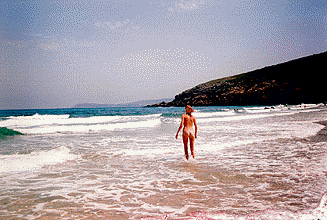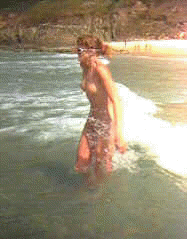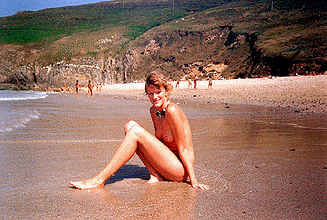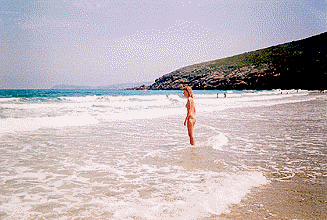La Costa Verde Naturist The Green fkk Coast
La Costa Verde naturist beaches which stretches as the crow flies, for over 1500 kilometers from the French Spanish border by the town of Irun to the Spanish Portuguese border by the river Mino. Enjoy textile free leisure on the many beaches of the Costa Verde Spain
The Green Coast
Costa Verde Naturist beaches Costa Verde, Spain
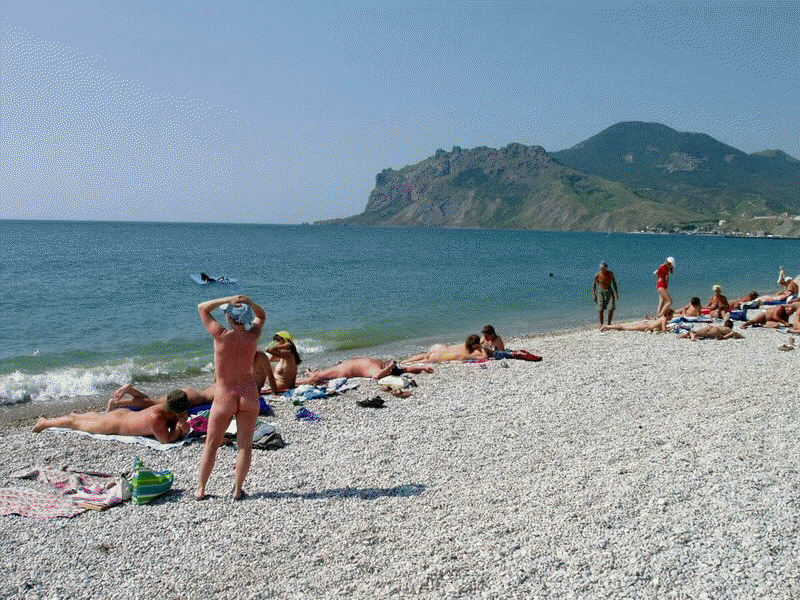
Without any doubt, Costa Verde naturist beaches are one of the most attractive and sought-after places to spend a holiday by many tourists coming to Spain.
Four out of five come to enjoy it’s coastline, which is bathed in sunshine and twice daily is covered by it’s clean and crystal clear waters.
Many tourists are looking for naturist beaches.
La Costa Verde (The Green Coast), stretches as the crow flies, for over 1500 kilometers from the French Spanish border by the town of Irun to the Spanish Portuguese border by the river Mino.
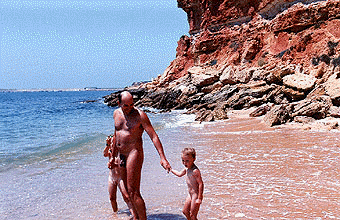
The Green Coast is so named due to it’s more temperate climate.
La Costa Verde is graced with more rainfall than the rest of Spain.
Sunshine is not guaranteed throughout the summer and therefore has not been so popular with the tourists as the Mediterranean or south coasts have been.
This in itself has been more of a blessing than a hindrance, as much of the coastline has not followed the same touristy development as the more popular “costas” further south and so it’s able to offer the visitors a more relaxed and natural surroundings.
The further west one travels the more evident this becomes.
There are many beaches to be found here along it’s length, with many suitable for fabric-free leisure naturist beaches La Costa Verde naturist .
The Vasque region
Starting in the Vasque region, the province of Guipuzcoa, we find our first popular naturist beaches near the town of Zarautz.
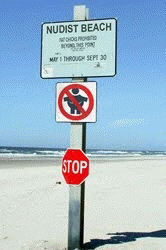
The entire length of this sandy beach is 2.5 km but only a small zone is Naturist.
This is right at one end by the golf course, where many textiles mix with textile-free.
This is a place where windsurfing has become very popular even among Textile free.
La Cantera
Our next beach takes us already into the next province: Vizcaya.
La Cantera La Costa Verde naturist beach is situated near the small village of Barrika some twenty kilometres east of Bilbao.
La Cantera is modest in size but well located geographically and affords some shelter from the sometimes rough seas of the Bay of Biscay.
Popular La Costa Verde naturist beach to some extent but not overcrowded.
Here all of the population is normally entirely fabric free with a few, if any, textiles.
Cantabria Costa Verde
Moving along to the neighbouring region of Cantabria, we find the naturist beach of La Arena, nicknamed “Los Textile free” which requires no translation!
This La Costa Verde naturist beach is found on the Ria de Ajo (The Garlic Fiord) by the town of Isla 35 km east of Santander.
The beach Costa Verde Spain does not face the ocean but is part of the fiord and so can be classified as an inland beach.
It is very popular, due again to the shelter it gives from the strong currents and wind that can sometimes ruin a good beach day.
Lots of sand and space with the added security and comfort afforded by it’s location, makes this beach a favourite among families with young children.
Playa Valdearenas
Staying in Cantabria, another La Costa Verde naturist beach worth mentioning has to be Playa Valdearenas; an awesome 3 km long sand bank is it’s main feature, giving bathing opportunities either facing the ocean or inland.
For this reason alone, it has become popular especially with Naturists which rule in numbers here.
Windsurfing Costa Verde Spain is also very popular at this spot.
To find it head for the town of Liencres laying about 12 kilometers west of Santander.
The beach is signposted from there. about 12 kilometres west of Santander.
This La Costa Verde naturist beach is signposted from there.
Our arrival port of Santander is the perfect gateway to some of the most beautiful, unspoilt parts of Spain, and provides easy access to south-west France.
Sailing from Plymouth or Portsmouth to Santander offers a much more relaxing alternative to flying.
And by taking your car, you’ll be free from airport delays, free from the hassle and expense of baggage restrictions, and free to explore the surrounding area at your own pace.
Asturias
Leaving Cantabria and entering the Principality of Asturias, we notice a gradual change in the contours of the coastline as it becomes more and more abrupt the more west we travel, in turn giving us more variety of landscapes and seascapes.
The most notable Naturist beach we encounter, after entering Asturias, has to be Playa Torimbia near Llanos or Llanes.
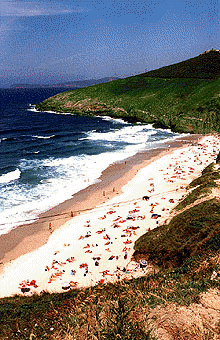
Set in a horseshoe bay and backed by a blanketed mount of lush green foliage without a building in site, gives one the feeling of being in a wild and virgin territory where one can be one with nature and indeed one can in more ways than one.
It’s white sands are ideal for that all over tan. Is regularly cleaned and raked every day and offers the naturist beaches goer 600 meters of paradise which is shared with its smaller neighbouring beach, Pestaña, also Naturist.
Atop of one of it’s neighbouring mounts one can have a fine view of all the surrounding bays and the spectacle of sunrise and sunset from here is something not to be missed.
WEEE
Traveling further west we now visit Playa Vega or sometimes simply called Berbes, an extensive sandy beach of 1.5 km, by 80 m. wide backed by gentle green sloping valleys.
Vega is a very popular beach, especially with the textiles but has a zone reserved for Naturist use.
If you like wide open spaces then this is the place to visit. Finding it is easy.
The turn off for la Vega is at kilometre 9 of the N- 632 national road, this is found 7 km west of Torrelavega.
Before we leave Asturias, one last beach has to be mentioned and this is the beach of Peñarubia, laying close to the city of Gijon.
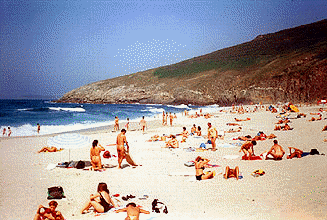
The beach is by default well visited especially on weekends.
Backed by impressive shear cliffs, which shelter it’s golden sands, the beach can be enjoyed on most days and offers a high degree of services and comfort with the added convenience of being so close to the city.
Galicia Costa Verde Spain
Having left Asturias and now entered the Kingdom of Galicia we find that in this the first province we enter through, Lugo, there is an unnatural void of beaches where Naturist recreation can be enjoyed.
One must travel further west until the province of La Coruña is reached before once again being able to feel the sun’s rays upon one’s entire body.
Here in Galicia the possibilities are almost endless for clothes free recreation with hundreds of possible fabric free spots and over 40 well known Naturist beaches.
The sheer diversity of the Galician land and seascapes make this land ideal for such activities and can, and indeed combines many more vacational interests hand in hand with Naturism.
Costa Verde Spain Naturist beaches
Accommodation list for Galicia
I am cursed by the fact that Galicia has so many fine sites to offer as I would undoubtedly run out of space if I were to describe them all. However I shall endeavor just to describe the top three or four,
On with Galicia –
The region offers Spain’s most articulated coastline with a total of over 5.000 km of actual shoreline, which is divided between its rocky shoreline, 1000 plus beaches, coves and fiords, some of which extend up to 30 km inland.
Exactly 744 of these places are actually usable bathing beaches so you will excuse me if I don’t name them all.
The first La Costa Verde naturist beaches we visit is the very popular beach of Barrañan, a small section of this beach, actually named Conbouzas, is used entirely for Naturism.
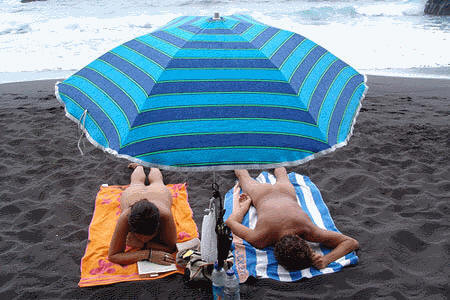
It’s popularity is due to it’s proximity to the ancient city of La Coruña, Conbouzas is but a short 12 km away from it’s city center.
Again this small section of Barrañan (Conbouzas) is surrounded by high green covered mounts giving the illusion of total isolation from the urban areas which one finds nearby.
The Naturist beach itself is small by comparison to it’s neighboring main textile beach in all approximately 1.5 km of beach backed both by the high mounts surrounding Conbouzas and extensive sand dunes on its textile side followed by rich and fertile agricultural land.
The sea can often be very choppy here and high waves are not uncommon even on the calmest of days.
La Costa Verde Naturist Castro De Barona
Passing by many extraordinary and unbelievable scenic beaches we arrive at our next stop Castro De Baroña, officially known as Area Longa.
This, the cot of Galician Naturism, is situated next to an ancient bronze-age town from which the beach takes it’s name.
Due to the popularity of this site, the beach has an insufferable number of textiles which completely overrun the beach on weekends squeezing the Naturists to both ends, many of which are offended by this intrusion of the textile public on an official Naturist beach.
Without shame or any exhibitionist reasons, they state their claim to the beach by parading among the textiles and refusing to be shoved to one corner by the majority.
The beach is well signed as a Textile free beach but still the prudes persist.
This is not the beach for you if a majority of textiles on a beach intimidate you.
To find it, turn into the driveway of the restaurant Castro Baroña at kilometer 58 of the C- 550 national road. From here it is a 1 km walk down a gentle slope to the beach.
Many more idyllic places exist from here along the way to our next stop here Costa Verde Spain.
Most notable is the area of O’ Grove in the province of Pontevedra, which offers a profusion of La Costa Verde naturist beaches and coves for Naturist use all within walking distance of one another.
La Costa Verde Naturist peninsula of Cangas de Morrazo
Having once arrived at the peninsula of Cangas de Morrazo we can stay on the C-550 road until we arrive at km 111, near the small village of Hio and then head for Playa Barra.
Playa Barra La Costa Verde naturist must be said is one of Galicia’s, if not Spain’s, best Naturist beaches.
Costa Verde Spain It has ended the pearl of Galician Naturism.
I say this with many considerations in mind, set in an idyllic setting, backed by extensive sand dunes which are blanketed by a thick forest of pines and facing the very wide mouth of the Vigo fiord which in turn is protected from the force of the Atlantic by the Cíes Isles.
Playa Barra is well protected from harsh seas so common of this coast by these features and more, it’s white fine sand stretches for 1300 meters from end to end and has an average width of about 30 meters where hundreds of people enjoy this little piece of paradise as God intended.
It’s waters are shallow and calm and ideal for children to play and swim in.
The absence of any permanent structure adds to the atmosphere and complete integration with nature culminates in a completely relaxing and thoroughly enjoyable day.
The only sign of urban madness is when the time comes to retrieve one’s vehicle.
Unfortunately, due to the immense popularity of this beach, all the access roads are usually packed full with cars and it can be quite difficult to find a parking space or get out of one.
Parking is on a bumper to bumper basis, although several small private parking areas are provided at reasonable costs.
These do get full very quickly, so come early and stay late if you plan to visit.
End of the Green Coast La Costa Verde
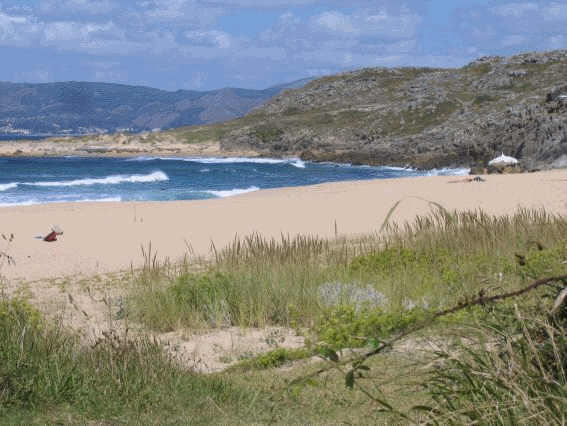
To end our tour of The Green Coast, we must, without a doubt, stop by Figueiras beach, yet another fine example of what this region has to offer to the Naturist of naturist beaches.
Playa Figueiras is not on the mainland but on the isle of Monteagudo, which forms part of the Cíes Islands situated, as stated above in the mouth of the Vigo Fiord.
To reach the island, ferries can be boarded from Vigo’s main harbour or Cangas on the north side of the fiord.
The isle lays about 7 nautical miles from these ports and the ferry ride takes approximately 50 minutes.
There are no cars on the island and the only possible overnight accommodation is a small camping site.
The whole island group has been turned into a natural reserve and some very impressive panoramic views of the Vigo Fiord and its surroundings can be enjoyed from the top of its highest mount: Monte Faro.
La Costa Verde Naturist beaches
Accommodation list for Vigo
Playa Figueiras faces slightly inland and is offered protection from the Atlantic by its northern peek, Mount Agudo.
This La Costa Verde naturist beach is only 500 meters north from the boarding dock so it is easy to find. The very nature of the island, extremely whitish sand, gives a good all-round tan. It’s waters, although cool, are extremely clean and clear.
They are also calm and safe for small children to play in. Sheltered as it is from the Atlantic, the weather influences a shortage of a cooling sea breeze and this is most noticeable where temperatures on this side of the island can reach the high thirties or forties quite often in summer.
Luckily La Costa Verde naturist the beach is surrounded by a thick pine forest where one can find shelter from the scorching heat if a dip in the sea is not always to your liking or convenience.
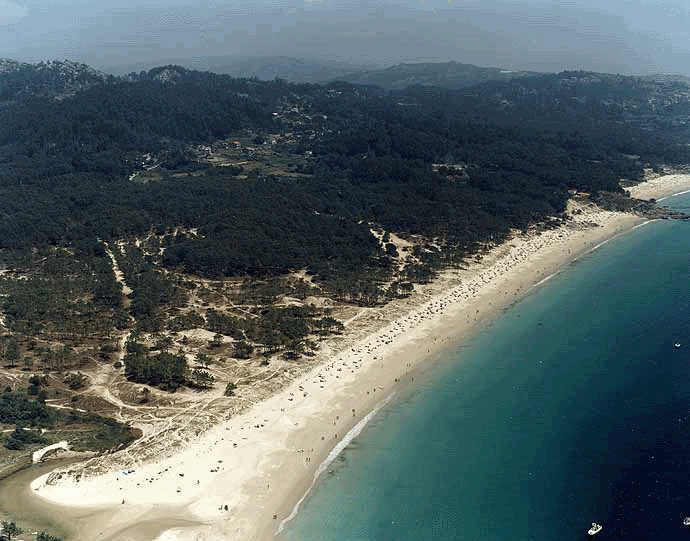
That concludes our whirlwind tour of La Costa Verde. Next time you are thinking of a holiday in Spain … think Green, where getting close to nature is only natural!
Tourist Board Costa Verde Spain estimates that around 1.5million tourists visit Spain every summer with the express aim of practising naturism.
If you found the page of use to you? Would YOU like to leave a donation: towards upkeep of site and research
Costa Verde index
La Costa Verde Naturist
Benidorm Old Town very popular destination all year round
Naturist potential beaches where you may feel at ease on the Cape Verde Islands
A few ideas of Naturist potential
Naturist potential some beaches and resorts in Cape Verde are known to be welcoming to naturists, though they may not officially advertise as such.

Nudist-Friendly Beaches and Resorts in Cape Verde
While public nudism may be restricted, there are a few nudist-friendly spots where naturists can feel at ease. Some beaches and resorts in Cape Verde are known to be welcoming to naturists, though they may not officially advertise as such. Here above are a few suggestions:
Sept 22 414927 Feb 4 March 4 Aug 10 F
Spain Info Urb Marina, San Fulgencio, 03177, Alicante, Spain.
Site Disclaimer
Disclaimer: Whilst every effort has been made to provide accurate information, no liability will be accepted for misinterpretation, misrepresentation, errors or omissions - the information provided by our Websites is for use as a guide only and is issued in good faith as information..
All photographs images and FILM material is subject to the understanding that as they are in the public domain they can be used and shared as seen to be appropriate and unless showing a sign that they are covered by copyright law. This also covers Social media operations.
1999---2026
